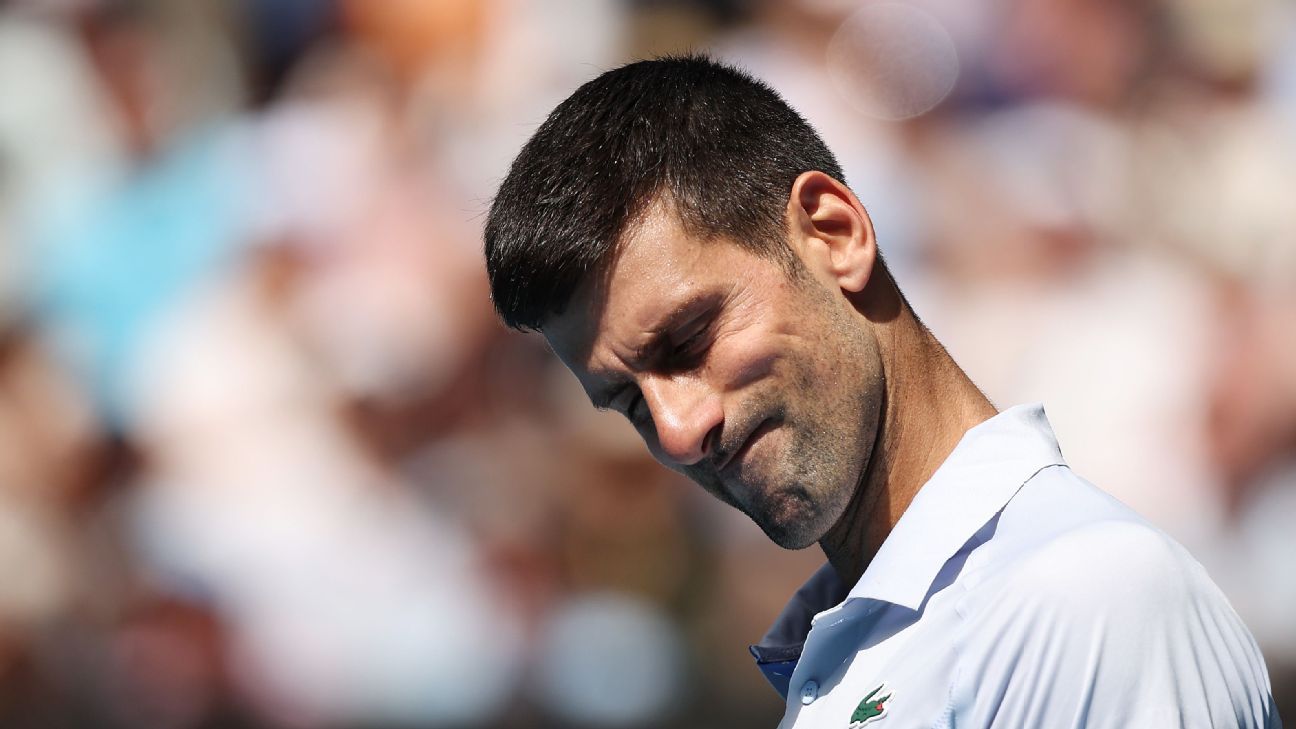MELBOURNE, Australia — There were plenty of reasons to suggest Jannik Sinner could spoil Novak Djokovic‘s quest for a record-breaking 25th major title when the pair met Friday in the semifinals of the Australian Open.
Sinner had been the most in-form player of the tournament, winning 15 consecutive sets in the lead-up to the match. His dominance in the early rounds meant he was also the fresher of the two, with Djokovic having spent close to four additional hours on court through his first five matches. And then there was recent history; Sinner the only player on tour to have beaten Djokovic twice in the last 18 months.
With that said, there was nothing — absolutely nothing — that remotely hinted Sinner could hand Djokovic one of his most shocking Grand Slam losses. Here are three takeaways from Sinner’s 6-1, 6-2, 7-6 (6), 6-3 semifinal win over Djokovic.
Djokovic beat himself, in a way we’ve never seen
The version of Djokovic that stepped onto Rod Laver Arena Friday was something never before seen at Melbourne Park, the venue where he has almost exclusively played the best tennis of his illustrious career.
The warning signs were there from the opening game of the match. Djokovic hit two balls long and another one wide to gift Sinner a comfortable hold of serve. Was it a loosener? Not exactly, rather a concerning theme that lasted throughout the semifinal.
Djokovic made a total of 15 unforced errors in the first set and another 14 in the second; his ability to find his range during rallies completely abandoning him. In the blink of an eye, Sinner had a two-sets-to-love lead and had relinquished just three games.
The 10-time Australian Open champion was able to avoid a straight sets defeat by taking the third in a tiebreak, but at no point did it feel as if momentum was shifting. Sinner forced another break of serve in the third game of the fourth set and didn’t look back, as Djokovic’s errors and frustrations continued to mount.
By the end of the match, Djokovic had struck 54 unforced errors, almost twice the amount of Sinner. He won just 67% of first-serve points and 25% of return points. But the most eye-catching statistic was total points won, Sinner winning 30 more than Djokovic over the course of the match. Not only that but the 34% of games he won in the match was the least he’d had in a completed match at the tournament since 2007.
“Look, I was, in a way, shocked with my level, you know, in a bad way,” said Djokovic. “There was not much I was doing right in the first two sets. I guess this is one of the worst Grand Slam matches I’ve ever played. At least that I remember.”
Djokovic’s struggles, combined with Sinner’s serving prowess, meant the world No. 1 never even got a look at a break point — the first time in his major career that’s happened. It was the type of one-sided Australian Open semifinal usually reserved for Djokovic. This time he was on the losing end of it.
It’s not just Carlos Alcaraz leading the next gen wave
Jo-Wilfried Tsonga. Stan Wawrinka. Denis Istomin. Hyeon Chung. And now, Sinner.
Since Djokovic became a Grand Slam champion, at this very tournament in 2008, just five men have beaten him at the Australian Open. And while all five matches were shocking in their own right, nobody knocked off the King of Melbourne Park in more dominant and spectacular fashion than Sinner.
In many ways it was a Djokovic-esque performance from the Italian. He kept the unforced errors low, tracked balls down from all over the court and continually made Djokovic play balls he didn’t want to have to touch. He was also efficient with his break point opportunities and lifted in the pressure moments.
There were signs last year Sinner was readying himself for a breakout season. The 22-year-old reached the semifinals at Wimbledon — where he lost to Djokovic in straight sets — before claiming his first Masters 1000 title a few months later in Canada. Sinner closed the year by finishing runner-up at the ATP Finals and then leading Italy to Davis Cup glory. At both events he tasted success against Djokovic, something which has given him newfound confidence.
Not two months later and Sinner has reached the Australian Open final, the youngest man to do so since Djokovic in 2008. What’s more, regardless of who he plays Sunday, he’ll start the match as the favorite to lift the Norman Brookes Challenge Cup.
Write Djokovic off at your own peril
This loss may have some penning the Djokovic obituary. They’ll argue, at 36, Father Time has finally caught up to him and that if he can be beaten at Melbourne Park, he can be beaten anywhere. But you just cannot write off a champion.
Djokovic had an off day. It happens.
Prior to the semifinal loss, Djokovic had won 34 consecutive matches at the Australian Open, dating to 2018. He’d lifted the trophy at 10 of the last 22 Slams he’d contested and reached the final at every major he appeared in since Wimbledon, 2022.
Regardless of what happens in Sunday’s final, Djokovic will remain the world No. 1. And, for the foreseeable future, he will continue to be the most likely player to win any tournament he enters.
There’s no denying this lackluster performance against Sinner, but Djokovic still has the ability to compete at the highest level and win the most important trophies in the sport.
